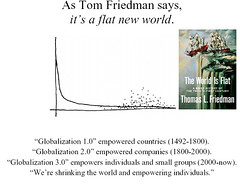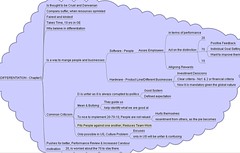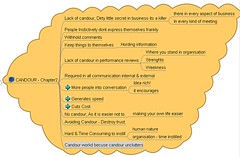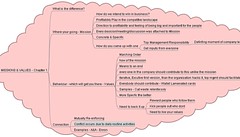Friday, April 29, 2005
Tuesday, April 26, 2005
Future of Enterpreise Software
Charles Phillips, President of Oracle , At software 2005
next step in oracle's roadmap. Excerpts:
- Although the old battles such as TCP versus token ring and the use of JDBC drivers are over, the acceptance of Java is still working its way through the industry. Traditionally, packaged applications used proprietary stacks- but Java is now finally becoming the de facto standard for applications.Oracle is still in midstream in the conversion over to Java for its applications. In addition, the industry is in the midst of standardizing on the expression of APIs with XML, standardizing on Web services, and designing component-based architectures.
- Beyond standardization, the next big move in the industry is toward vertical packaged applications rather than horizontal applications.
-The third major direction of the software industry is its move from being process driven to cross-process driven. Companies realize if they had the same data model across processes the quality of the information would be much higher. As Oracle owns so much of the stack, applications, middleware, and the database, it will intensify its efforts to create best practices around configurations that it will also certify.
via Sadagopan
The World is Flat
Just started listening(www.audible.com) to Tom Friedmans new book "the world is flat", well it's a very interesting book, below/attached are interesting notes/slides I found on the blogsphere about the book.
The post is a little long .
Via Emergic
The New York Times has an essay by Tom Friedman who has also written a book on the same topic: "It's a Flat World, After All."
I encountered the flattening of the world quite by accident. It was in late February of last year, and I was visiting the Indian high-tech capital, Bangalore, working on a documentary for the Discovery Times channel about outsourcing. In short order, I interviewed Indian entrepreneurs who wanted to prepare my taxes from Bangalore, read my X-rays from Bangalore, trace my lost luggage from Bangalore and write my new software from Bangalore. The longer I was there, the more upset I became -- upset at the realization that while I had been off covering the 9/11 wars, globalization had entered a whole new phase, and I had missed it. I guess the eureka moment came on a visit to the campus of Infosys Technologies, one of the crown jewels of the Indian outsourcing and software industry. Nandan Nilekani, the Infosys C.E.O., was showing me his global video-conference room, pointing with pride to a wall-size flat-screen TV, which he said was the biggest in Asia. Infosys, he explained, c! ould hold a virtual meeting of the key players from its entire global supply chain for any project at any time on that supersize screen. So its American designers could be on the screen speaking with their Indian software writers and their Asian manufacturers all at once. That's what globalization is all about today, Nilekani said. Above the screen there were eight clocks that pretty well summed up the Infosys workday: 24/7/365. The clocks were labeled U.S. West, U.S. East, G.M.T., India, Singapore, Hong Kong, Japan, Australia.
''Outsourcing is just one dimension of a much more fundamental thing happening today in the world,'' Nilekani explained. ''What happened over the last years is that there was a massive investment in technology, especially in the bubble era, when hundreds of millions of dollars were invested in putting broadband connectivity around the world, undersea cables, all those things.'' At the same time, he added, computers became cheaper and dispersed all over the world, and there was an explosion of e-mail software, search engines like Google and proprietary software that can chop up any piece of work and send one part to Boston, one part to Bangalore and one part to Beijing, making it easy for anyone to do remote development. When all of these things suddenly came together around 2000, Nilekani said, they ''created a platform where intellectual work, intellectual capital, could be delivered from anywhere. It could be disaggregated, delivered, distributed, produced and put back ! together again -- and this gave a whole new degree of freedom to the way we do work, especially work of an intellectual nature. And what you are seeing in Bangalore today is really the culmination of all these things coming together.''
At one point, summing up the implications of all this, Nilekani uttered a phrase that rang in my ear. He said to me, ''Tom, the playing field is being leveled.'' He meant that countries like India were now able to compete equally for global knowledge work as never before -- and that America had better get ready for this. As I left the Infosys campus that evening and bounced along the potholed road back to Bangalore, I kept chewing on that phrase: ''The playing field is being leveled.''
''What Nandan is saying,'' I thought, ''is that the playing field is being flattened. Flattened? Flattened? My God, he's telling me the world is flat!''
Well here is some critisism for the book/author....by Matt Taibbi
Start with the title.
The book's genesis is conversation Friedman has with Nandan Nilekani, the CEO of Infosys. Nilekani causally mutters to Friedman: "Tom, the playing field is being leveled." To you and me, an innocent throwaway phrase—the level playing field being, after all, one of the most oft-repeated stock ideas in the history of human interaction. Not to Friedman. Ten minutes after his talk with Nilekani, he is pitching a tent in his company van on the road back from the Infosys campus in Bangalore:
As I left the Infosys campus that evening along the road back to Bangalore, I kept chewing on that phrase: "The playing field is being leveled."
What Nandan is saying, I thought, is that the playing field is being flattened... Flattened? Flattened? My God, he's telling me the world is flat!
This is like three pages into the book, and already the premise is totally fucked. Nilekani said level, not flat. The two concepts are completely different. Level is a qualitative idea that implies equality and competitive balance; flat is a physical, geographic concept that Friedman, remember, is openly contrasting—ironically, as it were—with Columbus's discovery that the world is round.
Except for one thing. The significance of Columbus's discovery was that on a round earth, humanity is more interconnected than on a flat one. On a round earth, the two most distant points are closer together than they are on a flat earth. But Friedman is going to spend the next 470 pages turning the "flat world" into a metaphor for global interconnectedness. Furthermore, he is specifically going to use the word round to describe the old, geographically isolated, unconnected world.
"Let me... share with you some of the encounters that led me to conclude that the world is no longer round," he says. He will literally travel backward in time, against the current of human knowledge.
To recap: Friedman, imagining himself Columbus, journeys toward India. Columbus, he notes, traveled in three ships; Friedman "had Lufthansa business class." When he reaches India—Bangalore to be specific—he immediately plays golf. His caddy, he notes with interest, wears a cap with the 3M logo. Surrounding the golf course are billboards for Texas Instruments and Pizza Hut. The Pizza Hut billboard reads: "Gigabites of Taste." Because he sees a Pizza Hut ad on the way to a golf course, something that could never happen in America, Friedman concludes: "No, this definitely wasn't Kansas."
After golf, he meets Nilekani, who casually mentions that the playing field is level. A nothing phrase, but Friedman has traveled all the way around the world to hear it. Man travels to India, plays golf, sees Pizza Hut billboard, listens to Indian CEO mutter small talk, writes 470-page book reversing the course of 2000 years of human thought. That he misattributes his thesis to Nilekani is perfect: Friedman is a person who not only speaks in malapropisms, he also hears malapropisms. Told level; heard flat. This is the intellectual version of Far Out Space Nuts, when NASA repairman Bob Denver sets a whole sitcom in motion by pressing "launch" instead of "lunch" in a space capsule. And once he hits that button, the rocket takes off.
Sunday, April 24, 2005
Wednesday, April 20, 2005
Winning - Chapter 2
Today it's Chapter 2 from the book,
More on the approach & tools used in posts to come.
Winning - Chapter 1
Wednesday, April 06, 2005
Never Eat Alone
And one week later I am done with the book for those of you who know me, know that I am slow reader, but this book was fantastic, I made time to read it , I would read half hour in the morning and then see if I get some time at lunch to read a little more and so on it was a book like the cliché says "couldn’t put it down".
Well, I beielve that the book has given me some phenomenal insights, I have learned one hell of a lot from the book, well!! to put it simply I need the book,
While reading the book I also looked up the site / blog of Kieth Ferrazzai (the author) on the book, there were some interesitng articles there, I read every one of them. So should you!. This book is going to be my carry everywhere / read multiple times book, I think I can learn something each time I read it.I recommend that everybody should read this book , better yet should own a copy of it.
This post I am not going to get into the details of the book , but you can in future expect constant posts about it and my implementation of it.
Update: Check out this entry at the Never Eat Alone Blog, One of the readers has summarised the key points of the book in the form of a document ...very cool.




